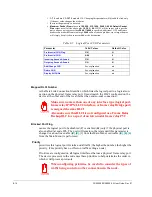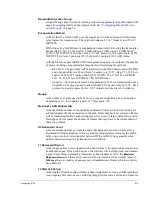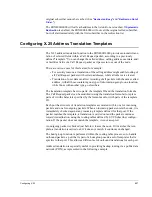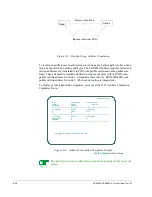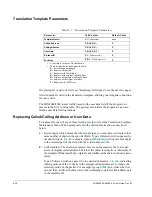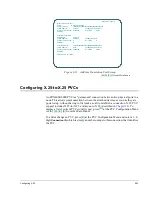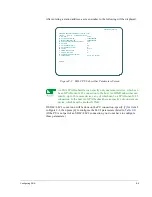
Configuring X.25
8-27
original subscriber cannot be reached. (See "
Redirect on Busy
" and "
Redirect on Out of
Order
.")
The FRX4000/6000 will call each address in the list until one is reached. If
Systematic
Redirection
is enabled, the FRX4000/6000 will not call the original called subscriber,
but will start immediately with the first subscriber in the redirection list.
Configuring X.25 Address Translation Templates
The X.25 address translation function in the FRX4000/6000 provides automatic trans-
lation of selected fields within a Call Request packet, according to a previously
defined "template." You can change the called address, calling address, user data, and/
or facilities fields of a Call Request packet as it passes into or out of the node.
There are various uses for this feature; for example:
●
For security reasons, a translation of the calling address might enable routing of
all Call Request packets with certain addresses, while all others are cleared.
●
Translation of user data can allow rerouting of all packets with the same called
address, with all those containing one type of information going to one location,
while those with another type go elsewhere.
The translation template has two parts: the template ID and the translation formula.
The Call Request packet can be modified (using the translation formula) to replace
parts of it with characters specified by the formula and/or with parts of the template
ID.
Each port has two sets of translation templates associated with it, one for incoming
packets and one for outgoing packets. When an incoming packet enters the node, it is
immediately checked against any incoming template defined for that port. If the
packet matches the template, a translation is carried out and the packet continues
toward its destination, using the routing tables defined by SVC Subscriber configu-
ration. If the packet does not match the template, it is not accepted.
An outgoing packet is checked just before it leaves the node. If it matches the tem-
plate, a translation is carried out; if it does not match, it continues unchanged.
The hunt group function is performed within the routing table process, so to handle
outbound packets, a port that is part of a hunt group needs a set of templates that is
specific to that port. This allows a different set of outbound translations for each port.
Address translation is especially useful in providing backup routing via a public data
network (PDN), as represented in the following example.
Summary of Contents for Netlink FRX4000
Page 2: ......
Page 16: ...xiv FRX4000 FRX6000 4 0 User Guide Rev 01 ...
Page 17: ...Section I Getting Started ...
Page 18: ......
Page 24: ......
Page 37: ...Section II Configuration ...
Page 38: ......
Page 52: ......
Page 78: ......
Page 106: ...7 24 FRX4000 FRX6000 4 0 User Guide Rev 01 ...
Page 142: ...8 36 FRX4000 FRX6000 4 0 User Guide Rev 01 ...
Page 186: ......
Page 216: ......
Page 266: ......
Page 273: ...Section III Operation ...
Page 274: ......
Page 296: ......
Page 324: ......
Page 376: ......
Page 377: ...Section IV Appendices ...
Page 378: ......
Page 384: ......
Page 390: ......
Page 396: ......
Page 400: ......
Page 405: ...Menu Structure E 5 ...
Page 406: ...E 6 FRX4000 FRX6000 4 0 User Guide Rev 01 ...
Page 425: ......
Page 426: ......




